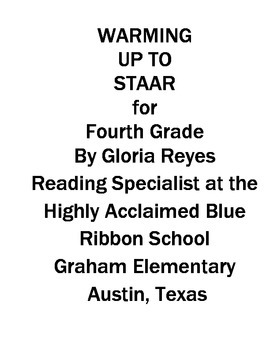4th Grade STAAR Reading: Warming Up to STAAR Reading
Reading Guru
114 Followers
Grade Levels
4th
Resource Type
Standards
CCSSRL.4.1
CCSSRL.4.2
CCSSRL.4.4
CCSSRL.4.5
CCSSRI.4.5
Formats Included
- PDF
Pages
201 pages
Reading Guru
114 Followers
Description
This year long workbook (201 pages) is designed as daily practices for bilingual, ESL, and struggling readers. Our school finds it beneficial for all our students, as it is a terrific review of foundational skills and academic vocabulary. Our fourth grade teachers have discovered it also aides in writing. Our students are now using more figurative language in their essays raising writing test scores as well as reading test scores. The book starts out on a very basic level to allow the teacher to see what gaps may exist in each student’s education. Skills are regularly reviewed throughout the workbook, which enables students to retain what they have learned. The questions in the text heavily focus on academic vocabulary and word study. Using this review has increased student achievement on standard academic testing by at least 20 % for most of our school population.
Total Pages
201 pages
Answer Key
Included
Teaching Duration
1 Year
Report this resource to TPT
Reported resources will be reviewed by our team. Report this resource to let us know if this resource violates TPT’s content guidelines.
Standards
to see state-specific standards (only available in the US).
CCSSRL.4.1
Refer to details and examples in a text when explaining what the text says explicitly and when drawing inferences from the text.
CCSSRL.4.2
Determine a theme of a story, drama, or poem from details in the text; summarize the text.
CCSSRL.4.4
Determine the meaning of words and phrases as they are used in a text, including those that allude to significant characters found in mythology (e.g., Herculean).
CCSSRL.4.5
Explain major differences between poems, drama, and prose, and refer to the structural elements of poems (e.g., verse, rhythm, meter) and drama (e.g., casts of characters, settings, descriptions, dialogue, stage directions) when writing or speaking about a text.
CCSSRI.4.5
Describe the overall structure (e.g., chronology, comparison, cause/effect, problem/solution) of events, ideas, concepts, or information in a text or part of a text.





